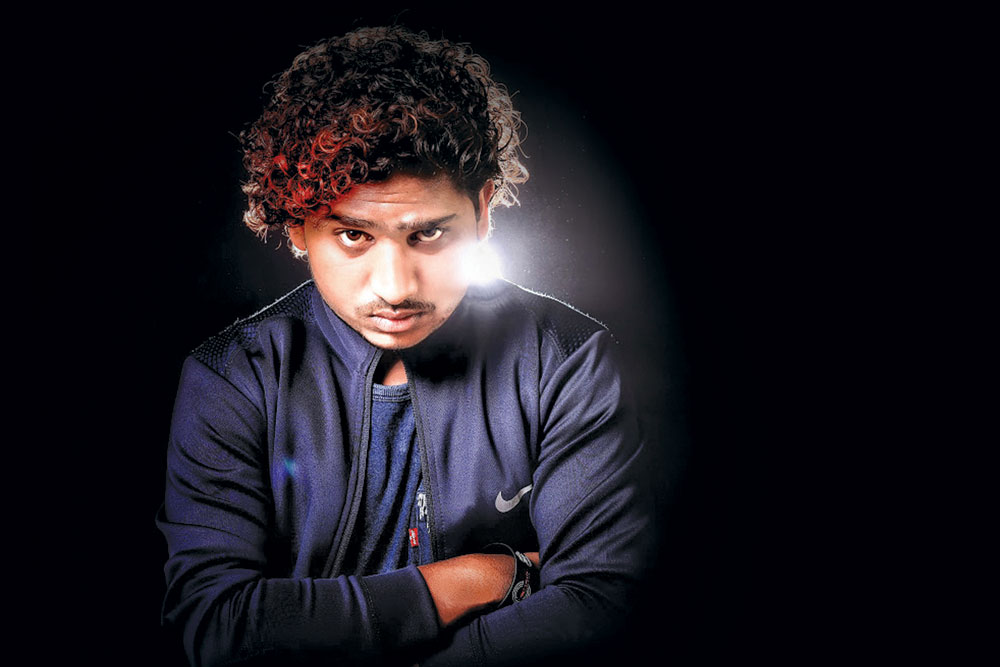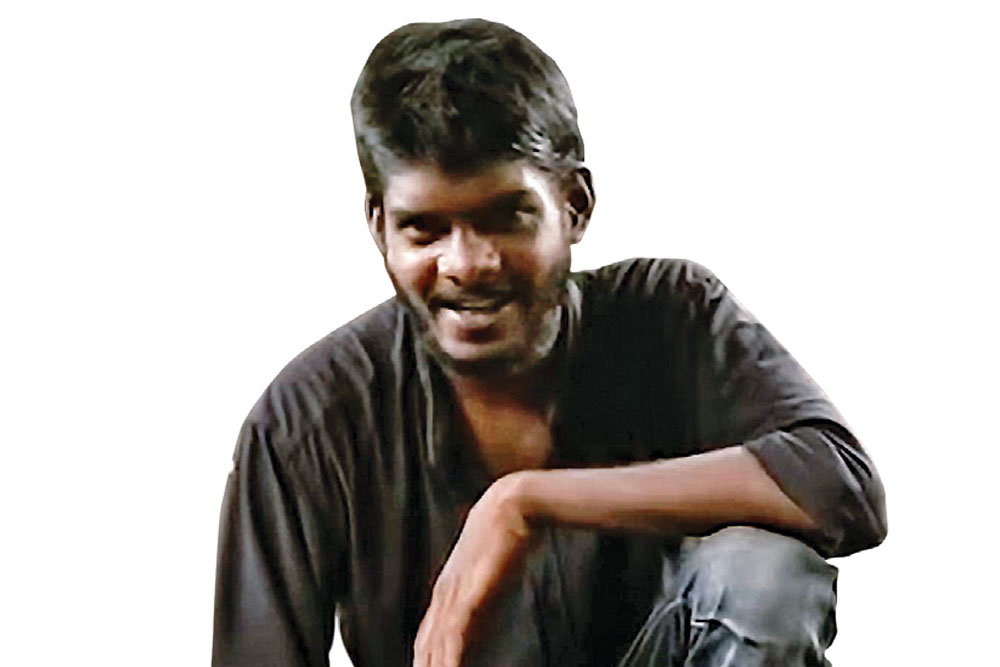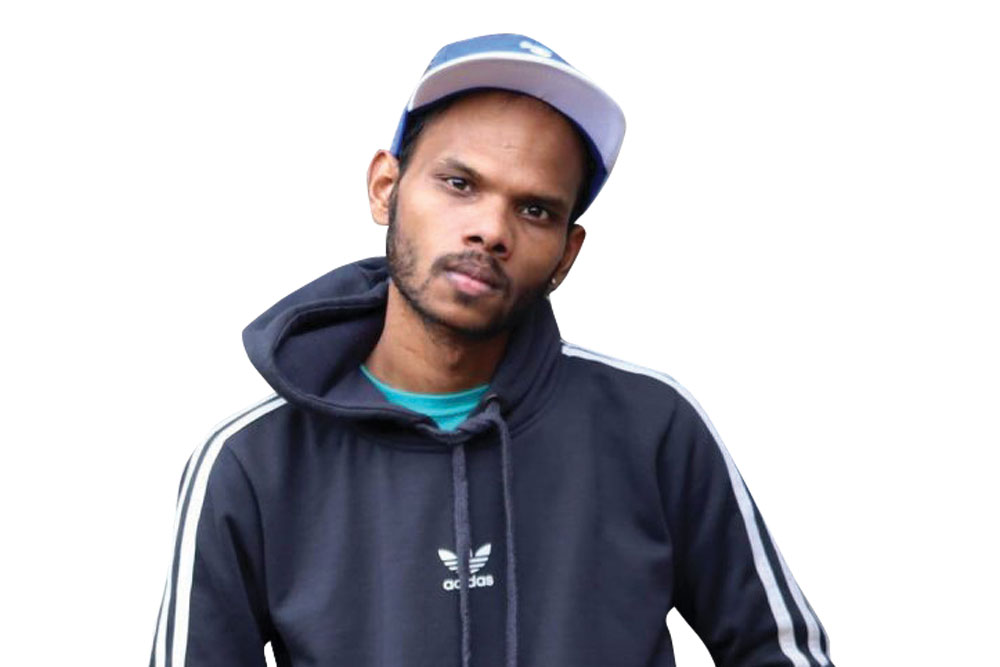/wp-content/uploads/2020/09/Therebelrap1.jpg)
Arivu
When Arivarasu Kalainesan looks back at his formative years, he can see that while other children were taught to be confident, his circumstances instilled in him a sense of inferiority. “From a very early age, my family taught me to be careful… of what I say, where I walk, who I play with. School, a space that is meant to be inclusive, reminded me of my caste for the smallest of my mistakes. I was teased for my dark complexion by friends, my appearance alienated me. With no means to fight back, I would cry to my mother, tell her that my very birth is wrong,” he says about his time in Arakkonam, a town on the outskirts of Chennai.
Today, however, that reality is behind him. Each time the 29-year-old takes the stage as Tamil rapper Arivu, he undergoes a transformation. Laced with anger, his voice climbs an octave; his body language is assertive as he belts out songs that talk about fighting against the caste system. “The stage is my place for debate, it’s my ideological battlefield where I present my pain and ask why the omnipresent oppression of my people has been
invisibilised for centuries.”
The Chennai-based anti-caste rapper believes this transformation is hard-earned—the consequence of a battle that raged within. “Throughout my college years, I tried to hide behind my poetry. My art would become the mask I wore to hide my caste identity, and I did succeed to an extent. My upper-caste friends would praise me for my poetry, respect me for my art but it did not change their mindset about caste,” recounts Arivu. It was only after he was selected as a member of The Casteless Collective, a group of anti-caste musicians brought together by acclaimed Tamil filmmaker Pa Ranjith and led by musician Tenma, in 2018 that Arivu decided to assert his caste identity. “It has shaped my voice as an artist.”
The stage is my place for debate, it’s my ideological battlefield where I present my pain and ask why the omnipresent oppression of my people has been invisibilised for centuries, says Arivu, Tamil rapper
In the two years since, the Tamil rapper has gained both fame and acclaim for his work. Arivu made his commercial debut first as a lyricist with ‘UrimayaiMeetpom’ (a song from the 2018 film Kaala, starring Rajinikanth) and then also as a singer with Vada Chennai’s ‘Mathiya Seraiyila’. While he continues to be associated with The Casteless Collective, last year, Arivu launched the album Therukural as an independent musician. What remains central to his work is his call for equal rights for all and, most importantly, the annihilation of caste.
This assertion fuels the growing tribe of anti-caste rappers from Dalit communities across India. Among Chennai-based Arivu’s contemporaries is 26-year-old Sumeet Samos, a multilingual rapper mixing Hindi and English with his mother tongue Odia. Samos, who goes by the name of Da-Lit Boy, is a graduate from Delhi’s Jawaharlal Nehru University and has been active since 2018. Back home in Tentulipadar, a village in Odisha’s Koraput district, Samos has used his time during the pandemic to focus on music, releasing six songs, several of which highlight the prevalent practise of casteism. In the song Jaati, for instance, Samos says, “Jaati hai ki jati hi nahi.” “Here, I quote Ambedkar where he speaks of caste-based discrimination as a monster that our people are unable to escape,” he explains.

While Ambedkar and his ideology are central to the music of several anti-caste rappers, they cannot be simply clubbed together. Their approach to music and what they hope to achieve through it differ. They also have their own politics and ideologies.
Take Gurkanwal Bharti aka Ginni Mahi, who rose to fame in 2016 for her song ‘Fan Baba Sahib Di’, a devotional track of sorts dedicated to Ambedkar. But it is her rap track ‘Danger Chamar’ that brought Ginni into national prominence. With this song, she not only asserts her identity but also subverts the image of the Chamar community, perceived to be a ‘danger’ in Punjab. As the hook of the song goes: “Qurbani deno darde nahin, rehnde hai tayyar, haige asle to wadd Danger Chamar” (The real Danger Chamars are those who don’t fear sacrifice).
As I explored international names like Tupac Shakur, I started to notice that their music was about their realities—race, poverty, inequality, says Vipin Tatad, who raps in Hindi and Marathi
The 22-year-old’s father, Rakesh Mahi, who also manages her career, says the family belongs to the community that follows the teachings of Sant Guru Ravidas and lives by Ambedkar’s ideology. The popular singer, who switches between rap, pop and Punjabi folk, started singing in her teens and was the first to arrive on the scene. She is currently pursuing her higher education in music and hopes to explore commercial Hindi music in future. “Since we belong to the Chamar community, Ginni’s songs do address caste but if you look at her music on the whole, at its heart is the message, ‘Equality for all’,” Rakesh Mahi points out.
For a majority of the rappers, their music feeds off the anger towards the oppression of an entire people and their own personal experiences. It is what made Hirandas Murali take on the avatar of Vedan (hunter). The Thrissur-based artist, who works as a daily-wage labourer, dropped his debut track ‘Voice of the Voiceless’ on YouTube in June this year. The song, which attacks caste and class discrimination and land grabbing by upper castes, has over 12 lakh views. “Who are the slaves and the lords of the irrigated fields? Who fenced them into thousand fragments? How many kinsfolk were decimated? Spines stooping, heads hanging, for how much longer?” he sings.

For these young, fearless voices that want to tackle the issue head on through music, rap may seem like the perfect fit. But both Samos and Arivu say that the genre is in fact incidental. “Having grown up without a television, I had no exposure to film songs or independent music. My only exposure was to the music of resistance in folk form. But once, while I was reading my poetry out loud, I did so with the anger and sorrow I had felt while writing it. That is when my friends pointed out that my style of recitation is similar to rap,” Arivu recounts. The incident pushed him to explore the genre and in the process, discover his favourite artist, Kendrick Lamar. Samos, too, had a similar experience. As anger bubbled over after an incident of discrimination he experienced at a mall in Delhi, he recorded a “rant” to vent his feelings and posted it on social media before he hit the bed. “By the time I woke up, it had over 10,000 views. My friends called me up to say that I should rap more often.”

For Ambedkarite artist Vipin Tatad from Maharashtra’s Amaravati, however, the genre came first. Drawn to the camera and video editing, Tatad had been brushing up his skills with wedding videos since high school. In 2016, an amateur rapper friend requested him to shoot a video, thereby introducing Tatad to the genre. “His rap was dedicated to Amaravati city. When he performed it, the song fell short in length. I pitched in with some lyrics that I also lent voice to,” the 24-year-old recounts.
The song went viral, inspiring Tatad. As with all other skills he had acquired, the musician turned to the internet in order to hone his amateur rapping. That is when he learnt that the genre has political roots. “Until then, I had only heard Indian rap artists like Honey Singh. But as I explored international names like Tupac Shakur, I started to notice that their music was about their realities—race, poverty, inequality.” Having grown up in Bhim Nagar, a slum that had for years been overlooked even as the government spruced up the city’s infrastructure, he could relate to the music. “The exposure taught me that real rap is supposed to highlight my reality.” Tatad, who had never witnessed Ambedkarite heroes, artists or culture projected in the mainstream, wrote ‘Samasya’, which he shot in the bylanes of his slum. The song was released in 2018 by Raptoli, a five-member music collective he is now part of. Mixing Hindi with a dash of
Marathi, he releases his songs on Raptoli’s YouTube channel, which has more than 3,500 subscribers.

This lack of representation in popular culture that Tatad speaks of is also an aspect that drives Arivu’s music. “Not only have our histories been invisibilised but also our cultures,” he rues, pointing out that Dalit and Adivasi beliefs and practices, their music and food have rarely been depicted with dignity. “What Pa Ranjith has done for our communities through his films like Madras, Kabali and Kaala, I wish to do with my music,” adds Arivu. Samos believes that Arivu, with his significant commercial success, has already been contributing in the direction. He cites the independent video that Arivu shot for ‘Theevira Vyaadhi’ from the Tamil film Gypsy (2020). In the song, the artist can be seen in a jacket with Ambedkar painted at its back and his quote, ‘Indifferentism is the worst kind of disease that can affect people’, written on a blackboard behind.
Dalit is not a homogeneous identity. The culture varies across regions but certain experiences will be common. Like the struggle to fit in an urban environment, says Sumeet Samos, rapper from Odisha
These musicians acknowledge the limitations of singing in their languages but they believe that their dialects also enrich their songs. Often passed off as crude or unpolished by the mainstream, their languages are replete with expressions and metaphors that encapsulate their people’s lived experiences. “Take the song ‘Desia Pila’. In our dialect, the phrase is used for someone from a slum. Now that cannot be translated without losing its impact. But I do pepper my songs with lines in Hindi and English for a bigger outreach,” says Samos, who considers college freshers his primary audience. “Dalit is not a homogeneous identity. The culture varies across regions and states but certain experiences will be common. Like the struggle to fit in an urban environment among English speakers when they first join college. I want them to know that they are not alone.”
Like Samos, Tatad too, falls back on the poetry—and rhythm—of Maharashtra’s rich culture of lokshahirs or people’s poets, who travel and sing songs about social issues to the mere beat of a daf. Arivu believes that one’s own culture can nurture music more than international hip-hop. “After all, the history of percussion instruments in India, made using animal skin, is directly connected to caste hierarchy,” he points out, adding that at a recent performance by The Casteless Collective, the artists used traditional percussion instruments like the parai (frame drum). The group often uses folk music forms like gana. “I am a rapper and my uncle is an ‘oppari’ [funeral lamenting] musician in Arakkonam. From the sorrow in our words to the beats of our genres, there is more in common between our music than most can imagine.” By including artists, genres and instruments that have been disregarded as inauspicious by upper castes, The Casteless Collective creates music that finds a wider audience beyond caste barriers in the hope of bringing them into the mainstream.
In a country where caste barriers are difficult to discuss, let alone break, making anti-caste music does not come without its share of hate. Most of the artists ignore the trolling, choosing to engage only with those who seem willing to debate. But these instances of engagement, even if few, are what these musicians are working hard for. Recently, during an Instagram Live session hosted by Samos, Arivu referred to his upper-caste friends from college. He pointed out that nothing much has changed—they disagree with his politics but follow and respect his music. As an artist, he says, it is his responsibility to help such people understand the other point of view. “So every song I write is my way of creating a discussion with them. My art, thus, becomes the means to bridge the gap that exists between us.”

/wp-content/uploads/2025/06/Cover-OpenMinds2025.jpg)














More Columns
Without govt aid, Musk will have to head back home to South Africa: Trump Open
Google Goes Nuclear Open
PM Modi marks 10 years of Digital India, highlights transformation Open